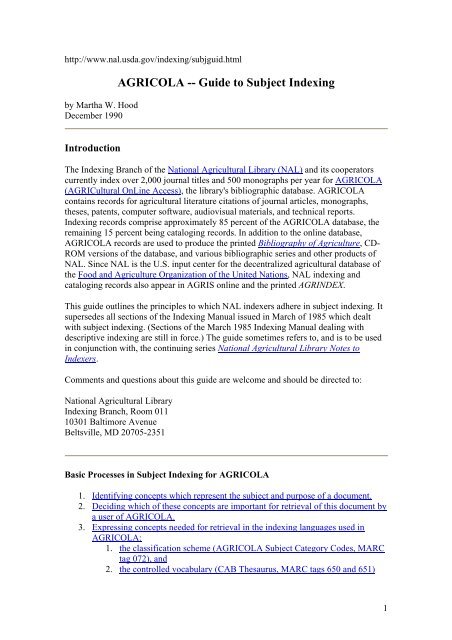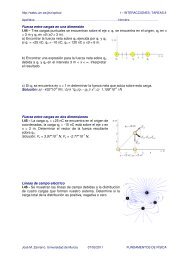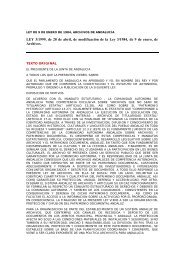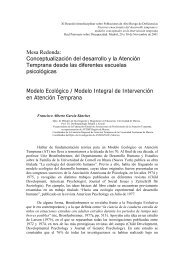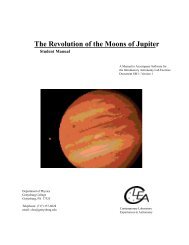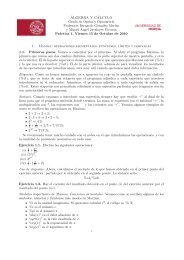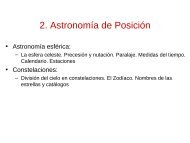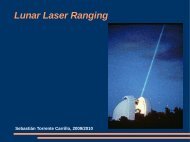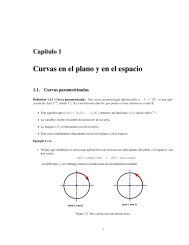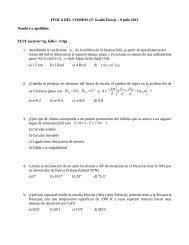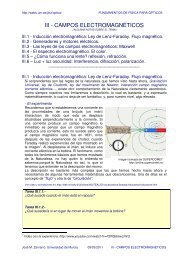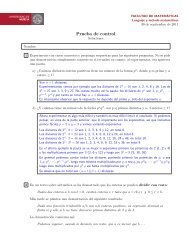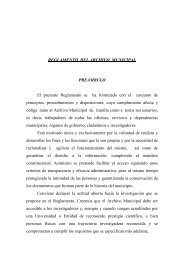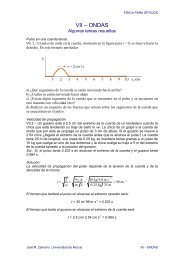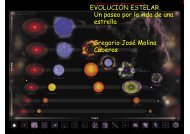AGRICOLA -- Guide to Subject Indexing
AGRICOLA -- Guide to Subject Indexing
AGRICOLA -- Guide to Subject Indexing
Create successful ePaper yourself
Turn your PDF publications into a flip-book with our unique Google optimized e-Paper software.
http://www.nal.usda.gov/indexing/subjguid.htmlby Martha W. HoodDecember 1990<strong>AGRICOLA</strong> -- <strong>Guide</strong> <strong>to</strong> <strong>Subject</strong> <strong>Indexing</strong>IntroductionThe <strong>Indexing</strong> Branch of the National Agricultural Library (NAL) and its coopera<strong>to</strong>rscurrently index over 2,000 journal titles and 500 monographs per year for <strong>AGRICOLA</strong>(AGRICultural OnLine Access), the library's bibliographic database. <strong>AGRICOLA</strong>contains records for agricultural literature citations of journal articles, monographs,theses, patents, computer software, audiovisual materials, and technical reports.<strong>Indexing</strong> records comprise approximately 85 percent of the <strong>AGRICOLA</strong> database, theremaining 15 percent being cataloging records. In addition <strong>to</strong> the online database,<strong>AGRICOLA</strong> records are used <strong>to</strong> produce the printed Bibliography of Agriculture, CD-ROM versions of the database, and various bibliographic series and other products ofNAL. Since NAL is the U.S. input center for the decentralized agricultural database ofthe Food and Agriculture Organization of the United Nations, NAL indexing andcataloging records also appear in AGRIS online and the printed AGRINDEX.This guide outlines the principles <strong>to</strong> which NAL indexers adhere in subject indexing. Itsupersedes all sections of the <strong>Indexing</strong> Manual issued in March of 1985 which dealtwith subject indexing. (Sections of the March 1985 <strong>Indexing</strong> Manual dealing withdescriptive indexing are still in force.) The guide sometimes refers <strong>to</strong>, and is <strong>to</strong> be usedin conjunction with, the continuing series National Agricultural Library Notes <strong>to</strong>Indexers.Comments and questions about this guide are welcome and should be directed <strong>to</strong>:National Agricultural Library<strong>Indexing</strong> Branch, Room 01110301 Baltimore AvenueBeltsville, MD 20705-2351Basic Processes in <strong>Subject</strong> <strong>Indexing</strong> for <strong>AGRICOLA</strong>1. Identifying concepts which represent the subject and purpose of a document.2. Deciding which of these concepts are important for retrieval of this document bya user of <strong>AGRICOLA</strong>.3. Expressing concepts needed for retrieval in the indexing languages used in<strong>AGRICOLA</strong>:1. the classification scheme (<strong>AGRICOLA</strong> <strong>Subject</strong> Category Codes, MARCtag 072), and2. the controlled vocabulary (CAB Thesaurus, MARC tags 650 and 651)1
4. Using uncontrolled vocabulary (identifiers, MARC tag 653) for concepts notrepresented or represented insufficiently specifically in the CAB Thesaurus.Each of these processes will be dealt with in detail in the pages that follow.1. Identifying Concepts Which Represent the <strong>Subject</strong> and Purpose of a Document.Follow these steps for every document <strong>to</strong> be indexed! You mayoccasionally get by with less, but over the long haul yourindexing will surely reflect whether you take this systematicapproach vs. a scattershot approach which quickly gleans a fewterms from the document's title.1.1. Understand the TITLE.1.2. Read the INTRODUCTION <strong>to</strong> the document for backgroundinformation and <strong>to</strong> locate the author's statement as <strong>to</strong> thepurpose of the article. This statement of purpose is oftenthe last sentence of the introduction. (But see 2.15.)Compare the statement of purpose with the title of thedocument <strong>to</strong> see that they correlate.1.3. Read the ABSTRACT as an aid for focusing your examination ofthe text. (You may want <strong>to</strong> reexamine the abstract at a laterstage in your indexing <strong>to</strong> verify that items in the abstractare actually substantively discussed within the text.)1.4. Scan the MATERIALS AND METHODS section for specific names oforganisms, geographic locations, procedures, etc.Information in the Materials and Methods section is oftenmore specific than elsewhere in the document.1.5. Note ILLUSTRATIONS, CHARTS, GRAPHS, and TABLES and theirlegends or captions. Also note headings, phrases, or wordsin BOLDFACE OR OTHER SPECIAL TYPEFACES.1.6. Scan the RESULTS. Don't overlook significant negativeresults.1.7. Read the CONCLUSIONS and/or SUMMARY and note actual findings,as differentiated from speculations or implications. It maybe helpful <strong>to</strong> compare the findings <strong>to</strong> the statement ofpurpose in the INTRODUCTION <strong>to</strong> see <strong>to</strong> what extent the purposewas realized.1.8. Scan the BIBLIOGRAPHIC REFERENCES for hints and confirmationif, at this point, you are still having problemsunderstanding the article or if you are looking for somespecific item of information (e.g., the meaning of anacronym).1.9. Scan any supplied KEYWORDS and/or RUNNING TITLES <strong>to</strong> see thatyou have considered all concepts indicated there. However,use these with care; they are not always well chosen. Don'tallow them <strong>to</strong> overrule your own good judgment.1.10. As a final aid in determining slant, consider the following:a) the type of journal in which the article appears,b) the organization with which the author is affiliated, and2
c) the funding source for the research.2. Deciding Which of These Concepts are Important for Retrieval of thisDocument by a User of <strong>AGRICOLA</strong>In making these decisions, consider both EXHAUSTIVITY andSPECIFICITY.EXHAUSTIVITY: You should index as many concepts as you deemnecessary <strong>to</strong> adequately represent the document in all itssignificant aspects.SPECIFICITY: You should index these concepts at a level of detailconsistent with the intended audience of the document and thetreatment of the subject in the document. Of course, thespecificity of descrip<strong>to</strong>rs available in the thesaurus is also aconsideration.It is vitally important <strong>to</strong> keep in mind that we are talking here ofCONCEPTS, not WORDS. Always remember that the same concept can beexpressed by many different words or combinations of words.For a longer discussion of indexing exhaustivity and specificity,consult <strong>Indexing</strong> Policy Memorandum No. 1, July 17, 1989.2.1. Give a high priority <strong>to</strong> concepts the author considersimportant as evidenced by the manner and frequency of theirtreatment in the document. (See 1.1 - 1.9.)2.2. However, also index concepts that you know <strong>to</strong> be important,on the basis of your own experience and judgment, even ifthey are not emphasized by the author.2.3. Index only information which warrants the time and expense ofretrieval, i.e., index concepts which are substantivelydiscussed, not just mentioned in passing.2.4. Index methods, techniques, and procedures only if they areone of the main <strong>to</strong>pics of the document. The appearance ofthe name of a method, technique, or procedure in the title ofan article is not sufficient justification for indexing it.There should be some textual discussion <strong>to</strong> the effect thatthe method is new, or modified, or applied differently, etc.,for it <strong>to</strong> be indexed.2.5. Index significant negative results. E.g., an articlereporting a study of antibiotic residues in beef should beindexed with descrip<strong>to</strong>rs for ANTIBIOTIC RESIDUES, BEEF, etc.,and a Category Code Q202, even if no residues are detected.2.6. Many concepts are composed of more than one fac<strong>to</strong>r, orcomponent. Index each concept completely, i.e., for all itsfac<strong>to</strong>rs. E.g., the concept "spleen weight" must be indexedwith descrip<strong>to</strong>rs for both SPLEEN and WEIGHT.2.7. Generally, do not index redundantly, i.e., do not index thesame concept at more than one level of specificity. E.g., donot index a document on bark beetles as pests with both BARK3
BEETLES and INSECT PESTS.2.8. However, do index the same concept both broadly and narrowlyif it is so treated in the article. E.g., a document maydiscuss analytical techniques in general, but concentrateupon gas chroma<strong>to</strong>graphy in specific detail; index with bothANALYTICAL METHODS and GAS CHROMATOGRAPHY.2.9. Give serious consideration <strong>to</strong> reflecting the level ofspecificity in the document in your indexing. E.g., indexcamel milk with the descrip<strong>to</strong>r CAMEL MILK, not MILK; indexdairy effluents with the descrip<strong>to</strong>r DAIRY EFFLUENTS, notEFFLUENTS.2.10. However, be aware that <strong>to</strong> do so may not always be appropriateor necessary. E.g., a Materials and Methods section mightidentify the cattle used in an experiment as Holsteins, butwhether <strong>to</strong> index the breed concept depends upon whether thisaspect of the study is emphasized in the document.2.11. There is no limit <strong>to</strong> the number of concepts which can beindexed for a particular document, and exhaustivity is oftencorrelated with indexing a large number of concepts perdocument. However, this is not necessarily true. Theinterplay of exhaustivity and specificity determines how manyconcepts are indexed. E.g., under some circumstances, it maybe desirable <strong>to</strong> index a document covering many aspects of asubject with just one broad, general concept; such a documentis exhaustively indexed at the proper level of specificitywith only one concept.2.12. In indexing, treat equally concepts which are treated equallyin the document. E.g., a document discusses five specificparameters of blood chemistry, giving approximately equalweight <strong>to</strong> all five; either index all five individually orindex <strong>to</strong> a broader concept that encompasses all five (BLOODCHEMISTRY), but do not index just two or three of the five.If, however, two of the five are emphasized significantlymore than the other three, it is appropriate <strong>to</strong> index thosetwo specifically, and also use BLOOD CHEMISTRY. (See 2.8.)For further discussion of accurate representation of conceptemphasis, consult <strong>Indexing</strong> Policy Memorandum No. 2, July 17,1989.2.13. Generally, do not index concepts which are present onlythrough implication or speculation. E.g., a document onmetabolism of omega-3 fatty acids should not be indexed withthe concept DISEASE PREVENTION, even though an understandingof omega-3 fatty acid metabolism may ultimately aid inreducing the incidence of cardiovascular disease.2.14. However, sometimes an implied concept must be indexed <strong>to</strong>provide the proper context for the other concepts. E.g., adocument discussing pathogenicity of a parasite for a pestinsect should be indexed with the concept BIOLOGICAL CONTROLeven if the author does not use this term.2.15. Documents usually contain references in the text <strong>to</strong> relatedwork of other authors. In particular, the all-importantINTRODUCTION may contain a brief literature review as abackground <strong>to</strong> or a rationale for the present study. Do not4
e misled in<strong>to</strong> indexing concepts that represent work notconducted as part of the research described in the documentat hand.3. Expressing Concepts Needed for Retrieval in the Two <strong>Indexing</strong> Languages Usedin <strong>AGRICOLA</strong>: the Classification Scheme and the Controlled Vocabulary.The classification scheme used for indexing <strong>AGRICOLA</strong> is the <strong>AGRICOLA</strong><strong>Subject</strong> Category Codes with Scope Notes (Modified AGRIS) and thecontrolled vocabulary is the CAB Thesaurus.These two indexing languages are independent of one another in thesense that each is a distinct system used <strong>to</strong> represent the subjectcontent of a document. The Category Codes assigned <strong>to</strong> a documentshould represent that document as completely as possible and withoutany necessity <strong>to</strong> refer <strong>to</strong> the descrip<strong>to</strong>rs assigned, and vice-versa.Naturally, this is not <strong>to</strong> say that there will not be relationshipsbetween the codes and the descrip<strong>to</strong>rs, but <strong>to</strong> point out that theyare used separately, not in combination with one another, <strong>to</strong>represent the document. Indeed, there may well be what appears atfirst blush <strong>to</strong> be redundancy in assignment of codes vis-a-visdescrip<strong>to</strong>rs and vice-versa.Descrip<strong>to</strong>rs representing the same concepts represented by theassigned Category Code(s) should always be assigned, though mos<strong>to</strong>ften the descrip<strong>to</strong>rs will be more specific than the codes <strong>to</strong> whichthey relate. To put this another way, a user should be able <strong>to</strong>comprehend why each Category Code was assigned by examining theassigned descrip<strong>to</strong>rs.The reverse, however, is not necessarily true; descrip<strong>to</strong>rs may beused <strong>to</strong> bring out aspects of the article which are not representedby the codes because these aspects are not treated in sufficientdepth or with sufficient emphasis <strong>to</strong> merit assignment of a code.In expressing concepts in the indexing languages, aim for as muchCONSISTENCY as possible in applying Category Codes and descrip<strong>to</strong>rs<strong>to</strong> represent concepts. Use the same code(s) and the samedescrip<strong>to</strong>r(s) <strong>to</strong> represent the same concept each time you index thatconcept. Our indexing will be valuable <strong>to</strong> <strong>AGRICOLA</strong> users onlyinsofar as it is CONSISTENT.3.1. <strong>AGRICOLA</strong> <strong>Subject</strong> Category Codes (MARC tag 072)NAL, as the U.S. input center, is a major contribu<strong>to</strong>r <strong>to</strong> AGRIS, adecentralized agricultural database maintained by FAO, the Food andAgriculture Organization of the United Nations. It is thereforeimportant that <strong>AGRICOLA</strong> and AGRIS Category Codes be compatible.AGRIS codes were found <strong>to</strong> be insufficiently specific for indexing<strong>AGRICOLA</strong> and the scheme was expanded, but in a manner which assuredeasy conversion of specific <strong>AGRICOLA</strong> codes in<strong>to</strong> broader AGRIS codes.In the <strong>AGRICOLA</strong> Category Code scheme, the field of agriculture isdivided in<strong>to</strong> 21 broad subject areas. Each of these areas is furthersubdivided, but even the subdivisions are very broad. Each of the5
subdivisions carries an alphanumeric notation consisting of oneletter (which remains the same within one of the 21 broad subjectareas) and three numbers. Each code also has a 'title,' known as a'section heading' (e.g., notation: J800 = section heading: SoilConservation).There are some hierarchical relationships within the scheme, e.g.:L830 Animal Diseases -- GeneralL831 Animal Diseases -- FungalL832 Animal Diseases -- BacterialL833 Animal Diseases -- ViralThe scope of each code is described by fairly lengthy notes, perhaps100 words or more. Included among these Scope Notes may becross-references indicating other codes which might be appropriateinstead of, or in addition <strong>to</strong>, the code at hand.There is an alphabetical index <strong>to</strong> the section headings and ScopeNotes.The Category Codes are used for:1. searching the database for broad subject areas, and2. arranging entries in the print version of the <strong>AGRICOLA</strong> database,the Bibliography of Agriculture.3.1.1. Assign up <strong>to</strong> three (3) Category Codes per document.3.1.2. Assign the codes in descending order of importance; use thefirst Category Code <strong>to</strong> represent the major <strong>to</strong>pic discussed.(Remember that this code determines where the documentappears in the Bibliography of Agriculture.)3.1.3. Use rela<strong>to</strong>r codes (K001, L001, L002, L003, M001) <strong>to</strong> narrowthe focus of large categories.3.1.3.1. Never place rela<strong>to</strong>r codes in first position.3.1.3.2. Never use rela<strong>to</strong>r codes without assigning at leas<strong>to</strong>ne other code.3.1.4. Assign Category Codes on the basis of the subject of the workactually conducted in the study at hand; do not assign themon the basis of what the subject can be used for.3.1.5. Follow the instructions in Scope Notes that sometimes specifythe order in which certain codes should be applied.3.1.6. Never assign codes on the basis of the alphabetical index;always consult the Scope Note itself before assigning a code.3.1.7. Emphasize pests and diseases over the normal processes ofplants and animals.3.1.8. Be alert <strong>to</strong> problems in, or the need for changes <strong>to</strong>, theScope Notes. Write a brief, informal memo (on 8 1/2 x 11inch paper) <strong>to</strong> the Category Code Coordina<strong>to</strong>r detailing theproblem. Keep a copy of this note in your Category Codenotebook. It will be useful when you are asked <strong>to</strong> comment onnew versions of the Scope Notes.6
3.2. CAB Thesaurus (MARC tags 650 -- subject descrip<strong>to</strong>rs -- and 651 --geographic descrip<strong>to</strong>rs)NAL uses a controlled vocabulary, the CAB Thesaurus, which iscompiled and maintained by CAB International in cooperation withNAL. This thesaurus is also used <strong>to</strong> index CAB Abstracts. Itincludes approximately 56,000 terms/phrases, of which approximately47,400 are DESCRIPTORS, or preferred terms, and 8,600 areNON-DESCRIPTORS, or lead-in vocabulary. These terms are arranged ina single alphabetical (word-by-word) sequence.Although there is a large number of precoordinated descrip<strong>to</strong>rs inthe thesaurus, the basic approach is that of post-coordination,where concepts are combined (coordinated) at the retrieval stagerather than at the indexing stage.Each descrip<strong>to</strong>r is accompanied by a WORD BLOCK which shows thedescrip<strong>to</strong>r's relationship with other descrip<strong>to</strong>rs in the thesaurus.There are three types of relationship represented in the wordblocks:HIERARCHICAL RELATIONSHIPSBT Broader TermNT Narrower TermThe BT/NT relationship is basically a generic/specific or part/wholerelationship, although the CAB Thesaurus does contain hierarchiesbased upon relationships other than these two.Hierarchies may contain up <strong>to</strong> seven (7) levels and all levels aredisplayed with each descrip<strong>to</strong>r.ASSOCIATIVE RELATIONSHIPSrt related termThis is used <strong>to</strong> represent relationships other than hierarchical.The 'rt' relationship is approximately equivalent <strong>to</strong> a 'see also'relationship.PREFERENTIAL RELATIONSHIPSuf used forUSE useThe 'uf' and USE relationships are reciprocals of one anotheremployed <strong>to</strong> relate synonyms, quasi-synonyms, and terms which standin various other relationships <strong>to</strong> one another. The term following a'uf' designation is a non-descrip<strong>to</strong>r, a non-preferred term. Theterm following a USE designation is a descrip<strong>to</strong>r, a preferred term.The USE relationship is approximately equivalent <strong>to</strong> a 'see'relationship. USE instructions are not optional, and must befollowed.Two other elements may be present in a word block:- a SCOPE NOTE, which may define or limit or give instructions forthe use of a descrip<strong>to</strong>r; and- a HISTORY NOTE, which indicates usage of the descrip<strong>to</strong>r over time,e.g., when it was added <strong>to</strong> the thesaurus, what descrip<strong>to</strong>r(s) wasused <strong>to</strong> index the concept before it was added, etc.7
3.2.1. If the term <strong>to</strong> which you first refer is a descrip<strong>to</strong>r, alwaysexamine its complete word block before assigning it <strong>to</strong> adocument.3.2.2. Choose the most specific suitable descrip<strong>to</strong>r in the wordblock.3.2.3. If the most suitable specific descrip<strong>to</strong>r in the word block isany other than the descrip<strong>to</strong>r <strong>to</strong> which you first referred,examine the word block of the descrip<strong>to</strong>r which you judge <strong>to</strong>be most suitable. The importance of this step cannot beoverstated.3.2.4. If the term <strong>to</strong> which you first refer is a non-descrip<strong>to</strong>r,proceed <strong>to</strong> the word block for the preferred descrip<strong>to</strong>r andexamine it completely. Never assign a descrip<strong>to</strong>r on thebasis of a USE reference without consulting the word blockfor the descrip<strong>to</strong>r. Again, the importance of this stepcannot be overstated.3.2.4.1. You may discover that the term <strong>to</strong> which you are beingreferred is in the wrong hierarchical context for the documentat hand.3.2.4.2. You may discover that a narrower term of the term <strong>to</strong>which you are being referred is more appropriate/specific.3.2.5. Do not index the same concept at two different levels of thehierarchy, i.e., do not assign both a BT and one of its NT's<strong>to</strong> represent the same concept. (See 2.7; but see also 2.8and Notes <strong>to</strong> Indexers, No. 9, November 1986).3.2.6. Do not assign a descrip<strong>to</strong>r <strong>to</strong> a concept that is inconsistentwith the context of the descrip<strong>to</strong>r's hierarchy. This is acritically important principle in indexing. If an indexerdoes not follow this instruction, s/he runs the risk ofseriously misleading a user and negating the value of using acontrolled vocabulary. We should be able <strong>to</strong> guarantee ourusers that we apply descrip<strong>to</strong>rs as consistently as possible.See: Notes <strong>to</strong> Indexers, No. 7, June 1986.3.2.7. It will often be necessary <strong>to</strong> assign more than one descrip<strong>to</strong>r<strong>to</strong> index a single concept. E.g., both COMPUTER TECHNIQUESand MAPPING are needed <strong>to</strong> represent the concept of "computermapping."3.2.7.1. On the other hand, do not use two descrip<strong>to</strong>rs <strong>to</strong>represent a concept when a precoordinated descrip<strong>to</strong>r for theconcept exists. E.g., for "amino acid biosynthesis," use AMINOACID METABOLISM, not AMINO ACIDS and BIOSYNTHESIS.3.2.8. If you don't readily find a descrip<strong>to</strong>r or combination ofdescrip<strong>to</strong>rs which represents a concept, be persistent.3.2.8.1. One good source is the KWOC index of the thesaurus.3.2.8.2. Another possibility is <strong>to</strong> search the <strong>AGRICOLA</strong>database on CD-ROM. Search for the concept free-text (i.e., asit occurs in titles and abstracts) and look <strong>to</strong> see whatdescrip<strong>to</strong>r(s) other indexers have used <strong>to</strong> represent it.3.2.9. Presently, there is only one rule concerning the order in8
originating from one country/area are studied in acountry <strong>to</strong> which they have migrated or been imported, donot apply a geographic descrip<strong>to</strong>r for the country oforigin. Apply the geographic descrip<strong>to</strong>r for the countryin which the subjects were studied; indicate theirgeographic or ethnic origin in some other way. E.g., anarticle about food habits of Cubans living in LongIsland would take NEW YORK and ETHNIC GROUPS asdescrip<strong>to</strong>rs. If CUBAN-AMERICANS is not in the title, itcould be used as an identifier. (See section 4.)However, this practice obviously should be applied onlyin the case of living subjects studied in a naturalenvironment. E.g., an article about insect specimenscollected in Ghana and studied in a labora<strong>to</strong>ry atHarvard University would take GHANA, not MASSACHUSETTS,as its geographic descrip<strong>to</strong>r.3.2.16. For plants and animals, the CAB Thesaurus may containdescrip<strong>to</strong>rs for the scientific (Latin) name, the commonname, or both, for the same organism. In applying thesedescrip<strong>to</strong>rs <strong>to</strong> agriculturally related plants andanimals, follow these general guidelines:3.2.16.1. Use the scientific name for plants throughharvesting.3.2.16.2. Use the common name for plants as commodities.3.2.16.3. Use the common name for domestic animals.3.2.16.4. Use the scientific name for pests and pathogens.3.2.16.5. Use the scientific name for wildlife.3.2.16.6. Certain articles may require both scientific andcommon names. Such articles may include, but are not limited<strong>to</strong>, those which emphasize the genetics/breeding of plants andanimals, especially with respect <strong>to</strong> genetic effects on theproducts of these plants and animals. E.g., an articlediscussing the fiber characteristics of cot<strong>to</strong>n produced by thesetwo different species of Gossypium and their hybrids wouldrequire COTTON; GOSSYPIUM HIRSUTUM; and GOSSYPIUM BARBADENSE.3.2.16.7. For scientific names, use the greatest level ofspecificity available in the thesaurus in field 650. This mightbe order, family, genus, or genus and species. If necessary,reflect a greater level of specificity in field 653. (See 4.5.)3.2.16.8. In cases where the use of a scientific name ismandated by these guidelines but is not available in the document athand, it is the responsibility of the indexer <strong>to</strong> seek it out. Often aquick way <strong>to</strong> do so is <strong>to</strong> search the <strong>AGRICOLA</strong> database on CD-ROM.However, common names are highly variable and often very localized.Therefore, if an indexer cannot trace the scientific name at any levelof the taxonomic hierarchy with some degree of certainty within areasonable period of time, it may be necessary <strong>to</strong> use a term such asMEDICINAL PLANTS, RUBBER PLANTS, WEEDS, INSECT PESTS, etc., in field650.3.2.17. Be alert <strong>to</strong> the possible need <strong>to</strong> propose descrip<strong>to</strong>rs foraddition <strong>to</strong> the thesaurus. <strong>Guide</strong>lines and forms forproposing terms are available as an Appendix <strong>to</strong> this <strong>Guide</strong> (AppendixB).10
4. Using Uncontrolled Vocabulary (Identifiers, MARC tag 653) for Concepts NotRepresented or Represented Insufficiently Specifically in the CAB Thesaurus.4.1. Identifiers are uncontrolled subject terms not found in theCAB Thesaurus either as descrip<strong>to</strong>rs or non-descrip<strong>to</strong>rs.4.2. Identifiers are not validated at data entry against anyauthority list.4.3. Use identifiers for significant local geographic concepts.E.g., add MILWAUKEE, WISCONSIN, <strong>to</strong> field 653 if the cityitself is emphasized. (WISCONSIN will of course be enteredin field 651.)4.4. Use identifiers for clarification of some abbreviations,acronyms, initialisms, etc., in document titles. E.g., UTMin a title is explained by adding UTERINE MILK in field 653.4.5. Use identifiers for taxonomic names. E.g., the speciesSENECIO ARVENSIS is not in the thesaurus and so must beentered in field 653. (SENECIO, which is in the thesaurus,will represent this species in field 650.)4.6. Use identifiers for proper names not in the thesaurus. E.g.,DISASTER ASSISTANCE ACT OF 1988; ALABAMA HOME ECONOMICSASSOCIATION; COALITION FOR PEACEFUL SCHOOLS.4.7. Do not repeat exactly title words or phrases as identifiers.However, if you think it may be useful, you may enter infield 653 some variant of a title word or phrase. E.g., forthe title "Negatively taxed farm expansion investments," itwas decided that NEGATIVE TAXES was a valuable entry in field653.4.8. Do not use as identifiers terms which appear in the CABThesaurus as descrip<strong>to</strong>rs even if the thesaurus descrip<strong>to</strong>rrepresents a concept other than the concept associated withthe term in the document at hand. E.g., the descrip<strong>to</strong>rGRANULATION carries a BT1 PLANT DISORDERS. It is notpermissible <strong>to</strong> enter GRANULATION in field 653 for a documentthat discusses granulation in some other context, such asfertilizer technology.4.9. Do not use as identifiers terms which appear in the CABThesaurus as non-descrip<strong>to</strong>rs. It is manda<strong>to</strong>ry <strong>to</strong> follow theUSE instruction in the thesaurus instead. E.g., thedescrip<strong>to</strong>r instructs: "sunlight USE solar radiation." It isnot permissible <strong>to</strong> enter SOLAR RADIATION in field 650 andSUNLIGHT in field 653.4.10. Always use some descrip<strong>to</strong>r from the CAB Thesaurus whichrepresents each concept being used as an identifier, even ifthe descrip<strong>to</strong>r is very broad. E.g., when you add in field653 EVOLSONIA TEXANA, a fossil plant that is not representedin the thesaurus even at the family level, add PLANTS infield 650.4.11. Do not use long phrases as identifiers; identifiers should bein the same general format as descrip<strong>to</strong>rs. E.g., EFFECT OFROTOTILLING ON GARDEN YIELDS is not an appropriateidentifier.11
4.12. Use identifiers liberally, but never as a short-cut <strong>to</strong> avoidsearching the thesaurus for an appropriate descrip<strong>to</strong>r.4.13. Identifiers that you find yourself using frequently may begood candidates for proposal as new descrip<strong>to</strong>rs. (See3.2.16.)ReferencesAGRIS -- <strong>Guide</strong> <strong>to</strong> <strong>Indexing</strong>. 23 (Rev.1) Rome: FAO-AGRIS, December1982.MEDLARS <strong>Indexing</strong> Manual. Part II. Bethesda, Md.: National Libraryof Medicine, 1981.British Standard Recommendations for Examining Documents,Determining Their <strong>Subject</strong>s and Selecting <strong>Indexing</strong> Terms.BS6529:1984. London: British Standards Institution, 1984.12
Appendix AA Checklist of <strong>Indexing</strong> ErrorsIt may be helpful <strong>to</strong> use this checklist <strong>to</strong> evaluate your ownindexing. It gives indexers a good indication of the kinds oferrors for which reviewers check during quality review in the<strong>Indexing</strong> Branch.1. Failing <strong>to</strong> index a significant concept.2. <strong>Indexing</strong> of a concept with an inappropriate term.2.1. Assigning term which is <strong>to</strong>o broad.2.2. Assigning term which is <strong>to</strong>o specific.2.3. Assigning term which is in the wrong hierarchical context.2.4 Assigning term which is inconsistent with Scope Note.3. <strong>Indexing</strong> of a concept that should be ignored.3.1. Insufficient information on concept <strong>to</strong> warrant retrievaleffort.3.2. Represents work not conducted as part of the researchdescribed in the document at hand.4. <strong>Indexing</strong> of the same concept at more than one hierarchicallevel.5. Failing <strong>to</strong> index all components/facets of a concept.6. Failing <strong>to</strong> index significant negative results.7. Failing <strong>to</strong> index with equal weight concepts which are treatedwith equal weight in the document.8. <strong>Indexing</strong> for implications or speculations.9. <strong>Indexing</strong> routine techniques, methods, or procedures.10. Failing <strong>to</strong> index significant geographic concept.11. Assigning geographic term which is insufficiently specific.12. Assigning geographic term for labora<strong>to</strong>ry/greenhouse research.13. Failing <strong>to</strong> assign Category Codes in proper order.13.1. Failing <strong>to</strong> assign Category Codes in descending order ofimportance.13.2. Failing <strong>to</strong> assign Category Codes in order mandated byScope Notes.14. Using rela<strong>to</strong>r Category Codes in first position, or alone.15. Failing <strong>to</strong> assign some descrip<strong>to</strong>r <strong>to</strong> represent each conceptwhich was assigned a Category Code.16. Failing <strong>to</strong> assign some descrip<strong>to</strong>r <strong>to</strong> represent each conceptwhich was assigned an identifier.13
16. First descrip<strong>to</strong>r does not represent major thrust of article orbelong <strong>to</strong> an acceptable group. (See 3.2.10 for acceptablegroups.)17. Failing <strong>to</strong> define title acronyms/abbreviations/initialism ineither the descrip<strong>to</strong>r or the identifier fields.18. Assigning an identifier that repeats a term in the documenttitle.19. Assigning a thesaurus non-descrip<strong>to</strong>r as an identifier.20. Assigning an identifier inappropriate in format and/or length.14
Appendix B<strong>Guide</strong>lines for Completing "Proposed Changes in CABThesaurus" Forms1. Please type all submissions.2. The <strong>to</strong>ne of any text in the "Justification" and "Additionalcomments" sections of these forms should be neutral andbusiness-like.3. Follow conventions of capitalization and indentation used in thethesaurus itself, i.e., capitalize descrip<strong>to</strong>rs, use lower casefor non-descrip<strong>to</strong>rs, etc.4. Use a separate form for each proposed change."Present descrip<strong>to</strong>r" section of form:5. In this section of the form, enter any existing CABdescrip<strong>to</strong>r(s) related <strong>to</strong> your proposed change <strong>to</strong>gether with pagenumber(s).5.1. It is very important that you search diligently for suchdescrip<strong>to</strong>rs.5.2. Consider spelling variants, synonyms, and quasi-synonymsbefore proposing a new descrip<strong>to</strong>r.5.3. Consider also that a combination of existing CAB descrip<strong>to</strong>rsmay express a concept adequately.6. If you are proposing a new USE reference <strong>to</strong> an existing CABdescrip<strong>to</strong>r, enter that existing descrip<strong>to</strong>r and its page numberin this section of the form."Proposed descrip<strong>to</strong>r" section of form:7. When proposing a descrip<strong>to</strong>r, observe the following:may7.1. Descrip<strong>to</strong>rs should always be nouns, noun-phrases, or gerunds.7.2. Noun-phrases should be written <strong>to</strong> exclude prepositions unlessdoing so violates accepted English usage.7.3. Adjectives are used only with nouns, e.g., RED LIGHT. CABIis adamantly opposed <strong>to</strong> the use of adjectives standing aloneas descrip<strong>to</strong>rs.7.4. Singular vs. plural: Use the singular form for processes,properties (attributes), and unique things. Use the pluralfor classes of things.7.5. Use natural word order. If deemed necessary, propose theinverted form as a non-descrip<strong>to</strong>r.7.6. Avoid punctuation, including hyphens, if at all possible.7.7. Use scientific rather than lay terminology. The lay termbe proposed as a non-descrip<strong>to</strong>r.8. When considering proposal of a new descrip<strong>to</strong>r, always askyourself these two questions:8.1. Will this descrip<strong>to</strong>r be used often enough <strong>to</strong> justify its15
addition <strong>to</strong> the thesaurus?8.2. Does this descrip<strong>to</strong>r represent a concept which can beconsistently and reliably differentiated from any otherconcept?Do not propose the descrip<strong>to</strong>r unless you can answer "yes" <strong>to</strong> bothof these questions."Justification for change" section of form:9. Authorities and references cited in support of proposed changesneed not comply with any standard format, but the citationshould be complete enough bibliographically that there will beno difficulty identifying the source, e.g., name of book, authoror edi<strong>to</strong>r, place of publication, publisher, date, pagenumber(s).10. The first source <strong>to</strong> consult when justifying a proposal isAGROVOC, FAO's multilingual thesaurus of agriculturalterminology. CABI, NAL, and FAO are all interested incompatibility between the CAB Thesaurus and AGROVOC; CABI willthus prefer an AGROVOC term in most cases over those from othersources. Always indicate on your form any related terms youfind in AGROVOC.11. For justification, consider other thesauri; specializeddictionaries, handbooks, monographs, and textbooks; and numbersof postings for the proposed concept in relevant databases.Generally, do not use all-purpose dictionaries."Hierarchy and rt" section of form:12. You must supply at least one BT1 (Broader Term) for eachproposed descrip<strong>to</strong>r (except in the rare instances when you maybe proposing a new <strong>to</strong>p term). This suggested BT1 must be avalid descrip<strong>to</strong>r in the CAB Thesaurus or a term you areproposing concurrently.13. The relationship between a term and its BT should, in mostcases, be a generic one, i.e., the broader term should denote aclass of concepts of which the narrower term is always a member.The part-whole relationship is also acceptable in some cases,e.g., for descrip<strong>to</strong>rs representing geographic locations, thoserepresenting ana<strong>to</strong>mical parts of an organism, those representingdisciplines. The thesaurus presently contains hierarchies basedon relationships other than these two types, but we wish <strong>to</strong>avoid adding any more.14. Provision of NT's (Narrower Terms) and rt's (related terms) isoptional. If you choose <strong>to</strong> do so, these should also be eithervalid descrip<strong>to</strong>rs in the thesaurus or terms you are proposingconcurrently."Additional comments" section of form:15. A term is assumed <strong>to</strong> include any of its common definitions. Ifcertain definitions are <strong>to</strong> be excluded from the scope of thedescrip<strong>to</strong>r or if uncommon definitions are <strong>to</strong> apply, this shouldbe made clear. The two primary methods of clarification wouldbe hierarchical placement or a scope note. Please supply thescope note if one is needed.16
16. If the <strong>Indexing</strong> Branch coordina<strong>to</strong>r, CABI, or users willencounter any difficulty in finding a definition for the term,please supply one in this section of the form. Indicate thesource for the definition if the source does not appear in the"Justification" section of the form.17
Proposed Changes in CAB Thesaurus___ New descrip<strong>to</strong>r___ New non-descrip<strong>to</strong>r (i.e., USE reference)___ Delete descrip<strong>to</strong>r___ Delete non-descrip<strong>to</strong>r___ Add rt (related term)___ Delete rt (related term)___ Change in hierarchy___ Problems with existing USE and uf references___ Spelling variance/error___ Substitution___ Word meaning/semantic variance___ Other (Please specify) __________________________________________Present descrip<strong>to</strong>r, if any (CABT, p. )Proposed descrip<strong>to</strong>r or proposed USE referenceJustification for change: Authorities, reference where proposed termwas used, number of postings in relevant databases, etc.Hierarchy and rt: Supply a BT1 either already existing in CABT orbeing proposed at this time or say why you cannot do so (manda<strong>to</strong>ry).Supply NT's and rt's either already existing in CABT or beingproposed at this time (optional).Additional comments relevant <strong>to</strong> the proposed change: Definition,proposed scope note, etc.Submitter's name, affiliation, phone/fax number, e-mail address18
Notes To IndexersNo. 1, January 1986 <strong>Indexing</strong> for Expert Systems and Related <strong>Subject</strong>sNo. 2, February 1986 Flocks vs. HerdsNo. 3, revisedSeptember 1989Bibliographies and Literature ReviewsNo. 4, March 1986 Category Code for Cut FlowersNo. 5, April 1986 Category Codes for Foods and FeedsNo. 6, May 1986 Rickettsiales Formerly Considered Pro<strong>to</strong>zoaNo. 7, June 1986 Application of Hierarchies in the CAB ThesaurusNo. 8, Oc<strong>to</strong>ber 1986 First descrip<strong>to</strong>rNo. 9, November 1986 Use of Hierarchically-Related Descrip<strong>to</strong>rsNo. 10, December1986New descrip<strong>to</strong>rsNo. 11, April 1987 Attributes of biological materialsNo. 12, July 1987 CAB descrip<strong>to</strong>rs ANALYSIS, BREEDING, and GROWTHNo. 13, September1987<strong>AGRICOLA</strong> <strong>Subject</strong> Category Codes J700 and P210No. 14, Oc<strong>to</strong>ber 1987 Category Codes for Insect PestsNo. 15, November1987Category Codes for WeedsNo. 16, November1987CAB Descrip<strong>to</strong>rs EGGS, OVA, and EGG PRODUCTIONNo. 17, January 1989 CAB Descrip<strong>to</strong>r LIFTINGNo. 18, February 1989 Diuraphis noxia (Mordvilko), the Russian Wheat AphidNo. 19, April 1989 Use of Geographic Descrip<strong>to</strong>rsNo. 20, January 1990 Imprint, MARC Tag 260No. 21, revised March1993Molecular Sequence DataNo. 22, September1990Use of PROTEIN/PROTEINS Descrip<strong>to</strong>rs in CAB Thesaurus1990 EditionNo. 23, September1990Britishisms and Americanisms in CAB Thesaurus 1990 EditionNo. 24, March 1993 Pneumocystis cariniiNo. 25, March 1994Selection Criteria and <strong>Subject</strong> Category Codes for ArticlesConcerning CyanobacteriaNo. 26, January 1998Subfields of MARC Tag 245--Implications for Creating 500Notes19
No. 27, June 2002<strong>Indexing</strong> Records for e-articlesNo. 1, January 1986SUBJECT: <strong>Indexing</strong> for Expert Systems and Related <strong>Subject</strong>sAgricultural applications of certain types of computer software are currently of interest:artificial intelligence, expert systems, decision-support systems, knowledge-base(d)systems, etc. In addition <strong>to</strong> using any other appropriate CAB Thesaurus descrip<strong>to</strong>rs, usethe descrip<strong>to</strong>r COMPUTER SOFTWARE and enter in field 653 whatever morespecific term is used for the software being described in the document at hand. The firstcategory code for such articles should relate <strong>to</strong> the agricultural application underdiscussion. Add X200 (Computer and Library Sciences) as a second category code.No. 2, February 1986SUBJECT: Flocks vs. HerdsUse the CAB descrip<strong>to</strong>r FLOCKS for: birds, goats, sheep.Use the CAB descrip<strong>to</strong>r HERDS for: camels, cattle, deer, elephants, horses, oxen,swine, whales.No. 3, revised September 1989SUBJECT: Bibliographies and Literature ReviewsBibliographies and literature reviews are coded in the 008 field of indexing records.This generates a note in the 500 field which is searchable online. However, users of thedatabase do not consistently search the Note fields, and they often display or printrecords in output formats which do not include these fields. Therefore, please assignCAB Thesaurus terms BIBLIOGRAPHIES or LITERATURE REVIEWS asappropriate, even though <strong>to</strong> do so may seem redundant.20
No. 4, March 1986SUBJECT: Category Code for Cut FlowersUse the S200 category code (Agricultural Products (Plant)) for flowers once they arecut, even for their post-harvest physiology, rather than using any of the F categorycodes.No. 5, April 1986SUBJECT: Category Codes for Foods and FeedsIn the case of composition, contamination, processing, s<strong>to</strong>rage, etc. of commoditieswhich could be destined for either food or feed, use both Q (Food Science and FoodProducts) and R (Feed Products) category codes unless it is clear which use is intended.No. 6, May 1986SUBJECT: Rickettsiales Formerly Considered Pro<strong>to</strong>zoaThe following microorganisms which were formerly considered <strong>to</strong> belong <strong>to</strong> thepro<strong>to</strong>zoa are now considered <strong>to</strong> belong <strong>to</strong> the rickettsiales (bacteria):• Aegyptianella• Anaplasma• Eperythrozoon• Haemobar<strong>to</strong>nella• ParanaplasmaDiscontinue indexing these genera using the L823 (Pests of Animals (Pro<strong>to</strong>zoa))category code. In the future, use L832 (Animal Diseases (Bacterial)).21
No. 7, June 1986SUBJECT: Application of Hierarchies in the CAB ThesaurusDo not use a descrip<strong>to</strong>r from the CAB Thesaurus unless the broader terms (the BTs) areconsistent with the meaning needed for the article you are indexing.• E.g., AGGREGATIONo BT1 statistical analysisDon't use the descrip<strong>to</strong>r AGGREGATION outside the context of statistics. It is notavailable, for instance, for use with aggregations of insects or of cattle.• E.g., DRYINGo BT1 dehydration• BT2 processingDon't use the descrip<strong>to</strong>r DRYING outside the context of human intervention in thedrying process. This is implied by the BT2 (PROCESSING). In cases such as thesetwo, search for a substitute descrip<strong>to</strong>r in the Thesaurus, add some other term <strong>to</strong> field653, or consider whether the appearance of the term in the title may suffice.This instruction applies even if some of the related terms (rt's) do have meaningsconsistent with the meaning needed for the article you are indexing.• E.g., CABINSo BT1 boats and shipso rt holiday chaletsThe descrip<strong>to</strong>r CABINS can only be used for the cabin of a boat/ship, not for a cabin inthe woods, despite the fact that the appearance of the rt HOLIDAY CHALETS leadsyou <strong>to</strong> believe that it might be. Other descrip<strong>to</strong>rs in this category include BEDDING,CHARGES, COMPRESSION, CROWN, and SUCCESSION.An obvious implication of these instructions is that an indexer should never use adescrip<strong>to</strong>r based solely upon the fact that it appears as a related term of anotherdescrip<strong>to</strong>r. Always check the full entry for the descrip<strong>to</strong>r itself so that you can inspectits own hierarchy.EXCEPTIONS:Some descrip<strong>to</strong>rs (e.g., drugs and agrochemicals, crops) have been placed in hierarchieson the basis of their uses or applications. It is permissible <strong>to</strong> use one of these descrip<strong>to</strong>rseven if the particular use <strong>to</strong> which it is being put in the article being indexed is notamong the BTs.22
• E.g., DICHLORVOSo BT1 anthelminticsDichlorvos is also used as an insecticide. You may use this descrip<strong>to</strong>r for articles wheredichlorvos is being used for insect control as well as for articles where it's being usedfor parasite control.• E.g., GLYCINE MAXo BT1 crop plants as weedso BT1 fodder cropso BT1 glycine (leguminosae)• BT2 leguminosaeo BT1 oil plantso BT1 vegetablesGlycine max is also sometimes used as a green manure. If that is its application in thearticle being indexed, you may use GLYCINE MAX as a descrip<strong>to</strong>r even thoughGREEN MANURES is not among the BTs.Generally speaking, if (1) more than one interpretation of a descrip<strong>to</strong>r's broader term(s)is possible or (2) if a descrip<strong>to</strong>r is a <strong>to</strong>p term (i.e., if it has no broader terms), you mayuse the descrip<strong>to</strong>r with somewhat greater freedom. However, cases in each of these twocategories must be judged individually, and possible differences of opinion about theirresolution are understandable. As such cases arise, they can be discussed and resolved at<strong>Indexing</strong> Problems Meetings.• E.g., POPULATION STRUCTUREo BT1 structureIt seems clear, based upon an inspection of the narrower terms (NTs) that humanpopulations were the original intent. However, the broader term STRUCTURE doesnot specifically tell a user of the Thesaurus that this is so, and the phrase "populationstructure" is often used in reference <strong>to</strong> animals. In this case, it would be permissible <strong>to</strong>use this descrip<strong>to</strong>r outside the context of human populations.• E.g., SELECTIONThis is a <strong>to</strong>p term; it has no BTs. However, based upon an inspection of the narrowerterms, it seems fairly clear that selection as a (natural or artificial) biological process isthe meaning intended. (All of the 36 NTs except HABITAT SELECTION areconsistent with this interpretation.) It would probably be inappropriate and unhelpful <strong>to</strong>use this descrip<strong>to</strong>r in the simple sense of making a choice.In the case of mixed hierarchies, the descrip<strong>to</strong>r can be used in the sense of any BT.• E.g., KEYSo BT1 taxonomyo BT1 <strong>to</strong>ols23
Such a hierarchy is clearly not desirable, but as long as it exists, an indexer may use thedescrip<strong>to</strong>r KEYS in the sense of either a <strong>to</strong>ol for opening a door or a dicho<strong>to</strong>mous keyfor identifying an organism. It is our understanding that many of these mixedhierarchies will be eliminated from the second edition of the Thesaurus.A USED FOR reference is not limiting in the same way that a hierarchy is.• E.g., MYCOSESo uf derma<strong>to</strong>mycoseso uf his<strong>to</strong>plasmosisThis is not <strong>to</strong> be construed as restricting the use of the descrip<strong>to</strong>r MYCOSES <strong>to</strong> thesetwo particular mycoses. In other words, "uf" means "used for"; it does not mean "usedexclusively for".No. 8, Oc<strong>to</strong>ber 1986SUBJECT: First descrip<strong>to</strong>rIn response <strong>to</strong> Sarah Thomas's memo of September 19, 1985, NAL indexing policy hasbeen <strong>to</strong> assign, if possible, as the first descrip<strong>to</strong>r one which is compatible with AGRIS'srequirements for a primary descrip<strong>to</strong>r. The question has arisen whether it is necessary <strong>to</strong>isolate a commodity, animal, etc., as the first descrip<strong>to</strong>r if the name of the commodity,animal, etc., appears as the first word of a precoordinated (multi-word) descrip<strong>to</strong>r. Theanswer is that it is not necessary <strong>to</strong> do so solely <strong>to</strong> comply with this policy.• E.g., An article on milk yield can be indexed with MILK YIELD as the firstdescrip<strong>to</strong>r. It is not necessary <strong>to</strong> use in field 650: milk; milk yield. An article oncattle diseases can be indexed with CATTLE DISEASES as the first descrip<strong>to</strong>r.It is not necessary <strong>to</strong> use in field 650: cattle; cattle diseases.It is, of course, necessary <strong>to</strong> use MILK in addition <strong>to</strong> MILK YIELD or CATTLE inaddition <strong>to</strong> CATTLE DISEASES if the subject content of the article warrants the useof both. In that case, enter MILK or CATTLE as the first descrip<strong>to</strong>r.No. 9, November 198624
SUBJECT: Use of Hierarchically-Related Descrip<strong>to</strong>rsOur general policy is <strong>to</strong> not assign CAB Thesaurus descrip<strong>to</strong>rs redundantly, i.e., do notassign both an NT and its BT <strong>to</strong> describe a single concept. However, there are cases inwhich it is necessary <strong>to</strong> use two generically related descrip<strong>to</strong>rs.1. A document deals with two concepts, for one of which the Thesaurus contains aspecific descrip<strong>to</strong>r, for the other of which only a broader term can be used.o E.g., A document deals with Anopheles gambiae, for which there is aspecific descrip<strong>to</strong>r in CABVOC, and Anopheles arabiensis, for whichthere is not. Enter in field 650: anopheles [<strong>to</strong> represent Anophelesarabiensis]; anopheles gambiae. Enter in field 653: anopheles arabiensis.o This is not <strong>to</strong> be construed as countermanding the prohibition againstentering terms in 653 which are represented in the title of the article, i.e.,in this particular case, if Anopheles arabiensis appears in the title, do notenter it in field 653.2. A document deals generally with a <strong>to</strong>pic, but also deals in detail with ahierarchically related concept.o E.g., A document gives a review of various analytical methods fordetecting tissue residues of pesticides and also concentrates on a new gaschroma<strong>to</strong>graphic technique for this purpose. GASCHROMATOGRAPHY is a narrower term <strong>to</strong> ANALYTICALMETHODS. Nonetheless, enter in field 650 both: analytical methods;gas chroma<strong>to</strong>graphy.o If, on the other hand, the article discusses only a gas chroma<strong>to</strong>graphicmethod, do not enter both ANALYTICAL METHODS and GASCHROMATOGRAPHY in field 650; enter only GASCHROMATOGRAPHY.No. 10, December 1986SUBJECT: New descrip<strong>to</strong>rsPlease be alert <strong>to</strong> two new descrip<strong>to</strong>rs which are of particular importance <strong>to</strong> two ofNAL's information centers.NUCLEOTIDE SEQUENCE = a specifically ordered row of nucleotides in the DNAor RNA of organisms. Data about nucleotide sequence are easily recognized by theappearance of typical figures. Authors may also use the terms "dna sequence", "rnasequence", or "gene sequence" for this concept.ANIMAL TESTING ALTERNATIVES = procedures such as tissue culture,mathematical models, in vitro assays or screens, etc., when used or advocated for use inplace of animals in research or diagnostic labora<strong>to</strong>ries. This descrip<strong>to</strong>r is also applicable<strong>to</strong> situations that involve substitution of an animal lower on the phylogenetic scale, such25
as a sea urchin, for a warm-blooded animal. These procedures are of interest and thisdescrip<strong>to</strong>r should be used even if authors do not point out this aspect of their work.No. 11, April 1987SUBJECT: Attributes of biological materialsWhen indexing articles which discuss, quantitatively or qualitatively, the presence of asubstance, or its constituents or metabolites, in (normal or abnormal) organs, tissues,body fluids, secretions, etc., assign CAB descrip<strong>to</strong>rs for both the substance and theorgan, tissue, etc., in which it occurs.• E.g., An article on plasma concentrations of copper should be indexed withBLOOD PLASMA and COPPER.• An article on acetylcholine in the brain should be indexed with BRAIN andACETYLCHOLINE.• An article on alkaloids in root tissues should be indexed with ROOTS andALKALOIDS.Similarly, when indexing articles which discuss other characteristics of organs, tissues,etc., assign CAB descrip<strong>to</strong>rs for both the characteristic and the organ, tissue, etc., whichit characterizes.• E.g., An article on weight of the adrenal glands should be indexed withADRENALS and WEIGHT.Note that the CAB Thesaurus does contain some precombined descrip<strong>to</strong>rs whichobviate the necessity of using two descrip<strong>to</strong>rs.• E.g., An article on age of leaves should be indexed with LEAF AGE, not withLEAVES and AGE.• An article on lipids in the blood should be indexed with BLOOD LIPIDS, notwith BLOOD and LIPIDS.The needed information will usually be found in the title, abstract, and/or introductionof an article, but it may sometimes be necessary <strong>to</strong> examine the materials and methodssection <strong>to</strong> locate it.26
No. 12, July 1987SUBJECT: CAB descrip<strong>to</strong>rs ANALYSIS, BREEDING, and GROWTHTry <strong>to</strong> use a more specific descrip<strong>to</strong>r than ANALYSIS whenever possible. Examine thehierarchies in the Thesaurus and your KWOC index of the Thesaurus for an appropriateterm. Very often you may want <strong>to</strong> use CHEMICAL ANALYSIS.Treat the descrip<strong>to</strong>r BREEDING as though it had this scope note: "Controlledimprovement of selected characters in animals or plants." The same applies <strong>to</strong>ANIMAL BREEDING and PLANT BREEDING. Always use one of these twodescrip<strong>to</strong>rs when appropriate rather than the general BREEDING. For breeding ofanimals in nature, use REPRODUCTION or a related descrip<strong>to</strong>r rather thanBREEDING. For reproductive (as opposed <strong>to</strong> genetic improvement) aspects ofbreeding of domestic animals, use REPRODUCTION or a related descrip<strong>to</strong>r ratherthan BREEDING.If the subject of an article is economic growth or population growth use the specificdescrip<strong>to</strong>rs ECONOMIC GROWTH or POPULATION GROWTH rather than usingGROWTH. Reserve GROWTH for biological growth. Delete the descrip<strong>to</strong>rsGROWTH ANALYSIS and GROWTH STUDIES from your copy of the Thesaurus.No. 13, September 1987SUBJECT: <strong>AGRICOLA</strong> <strong>Subject</strong> Category Codes J700 and P210Modify your copy of the scope notes for <strong>AGRICOLA</strong> <strong>Subject</strong> Category Codes asfollows:J700 SOIL CULTIVATION AND CROPPING SYSTEMS: delete the line which reads"Systems of cultivation under irrigation".P210 IRRIGATION AND DRAINAGE: delete the cross-reference which reads "use ofirrigation in cultivation, use J700".Effective immediately, adjust your indexing practice accordingly, i.e., J700 should nolonger be used for any aspect of the subject of irrigation.When irrigation systems are discussed as one aspect of general crop husbandry, it mayalso be necessary <strong>to</strong> add a plant production or forestry production category code (F1xxor K1xx).27
No. 14, Oc<strong>to</strong>ber 1987SUBJECT: Category Codes for Insect PestsModify your copy of the scope notes for the <strong>AGRICOLA</strong> <strong>Subject</strong> Category Codes asfollows: For codes F821 and L821:1. Delete this phrase: Biology of insect pests.2. Add this cross-reference: For aspects of the biology of insect pests, add L200through L700, as appropriate, and L001.For codes L200, L210, L300, L400, L500, L600, and L700:1. Add this cross-reference: For insect pests, add F821, F851, L821, L851, asappropriate.Effective immediately, adjust your indexing practice accordingly.No. 15, November 1987SUBJECT: Category Codes for WeedsModify your copy of the scope notes for the <strong>AGRICOLA</strong> <strong>Subject</strong> Category Codes asfollows:For code F900:1. Delete this phrase: Biology of weeds2. Delete these cross-references:o For: physiology and biochemistry of weeds, add F600o For: weed structure and morphology, add F4003. Substitute this cross-reference:o For aspects of the biology of weeds, add F200 through F700, asappropriateFor code F200, add this cross-reference:oFor weed genetics, add F900For code F300, add this cross-reference:28
oFor weed ecology, add F900For code F500, add this cross-reference:oFor weed nutrition, add F900Scope notes for codes F400, F600, and F700 already contain similar cross-references.Effective immediately, adjust your indexing practice accordingly.No. 16, November 1987SUBJECT: CAB Descrip<strong>to</strong>rs EGGS, OVA, and EGG PRODUCTIONEffective immediately, treat the CAB descrip<strong>to</strong>r EGGS as though it carried this scopenote:• Bird or reptile eggs used for food; for other eggs use OVA.Treat the CAB descrip<strong>to</strong>r EGG PRODUCTION as though it carried this scope note:• Commercial production of poultry eggs; for physiological aspects, considerFECUNDITY, OVIPOSITION, etc.No. 17, January 1989SUBJECT: CAB Descrip<strong>to</strong>r LIFTINGThe CAB descrip<strong>to</strong>r LIFTING is <strong>to</strong> be used only in the context of harvesting, as of rootvegetables or nursery s<strong>to</strong>ck. It should never be used for lifting by humans in othercontexts, lifting in the context of agricutural construction, etc.Do use LIFTING for:• Impact of physical injury and commercial lifting on damage <strong>to</strong> onion bulbs bylarvae of onion maggot.• Speed of germination affects diameter at lifting of nursery- grown loblolly pineseedlings.29
Do not use LIFTING for:• Back injury protection -- the inside s<strong>to</strong>ry.• Non-loop method of lifting construction productsNo. 18, February 1989SUBJECT: Diuraphis noxia (Mordvilko), the Russian Wheat AphidDiuraphis noxia, the Russian wheat aphid (also known as Brachycolus noxius, theRussian grain aphid, or the barley aphid) is a newly introduced pest posing a seriousthreat <strong>to</strong> North American small grain crops. Since 1986, it has spread from Texas <strong>to</strong>Saskatchewan, and damage <strong>to</strong> wheat and barley has been extensive in some parts of theU.S. Crop losses have currently been estimated at $100 million dollars.DIURAPHIS NOXIA has been introduced as a descrip<strong>to</strong>r in the second edition of theCAB Thesaurus, but it is not a descrip<strong>to</strong>r in the first edition. Until the <strong>Indexing</strong> Branchbegins <strong>to</strong> index using the second edition, please add DIURAPHIS NOXIA <strong>to</strong> theidentifier field (653) and HEMIPTERA <strong>to</strong> the descrip<strong>to</strong>r field (650) for all articlesdiscussing this pest.Annotate your copies of both editions of the Thesaurus so that they include crossreferences from other names for this pest <strong>to</strong> its scientific name, i.e.,• aphid, barley USE diuraphis noxia• aphid, russian grain USE diuraphis noxia• aphid, russian wheat USE diuraphis noxia• barley aphid USE diuraphis noxia• brachycolus noxius USE diuraphis noxia• grain aphid, russian USE diuraphis noxia• russian grain aphid USE diuraphis noxia• russian wheat aphid USE diuraphis noxia• wheat aphid, russian USE diuraphis noxiaNo. 19, April 1989SUBJECT: Use of Geographic Descrip<strong>to</strong>rs30
Use geographic descrip<strong>to</strong>rs liberally. These are entered in MARC tag 651 and can besearched with DIALOG suffix code /DE, with DIALOG prefix code GL=, with BRSlabel .DE, on SilverPlatter as IN DE.Situations in which geographic descrip<strong>to</strong>rs should usually be applied include, but arenot limited <strong>to</strong>, the following:• There is a geographical term in the title.• There is a map in the article.• A survey has been carried out.• Field research has been carried out.• Flora or fauna of a region has been studied.• New taxa or other taxonomic information are a <strong>to</strong>pic.• Organizations or institutions are a significant <strong>to</strong>pic.• The article is biographical in slant.Give serious consideration <strong>to</strong> using a geographic descrip<strong>to</strong>r when any of the followingare subjects of a document:• Ecology, including pollution.• Economics.• Education/training.• Epidemiology.• His<strong>to</strong>ry.• Human ecology.• Land and/or water resources.• Legislation, jurisprudence, or politics.• Meteorology/clima<strong>to</strong>logy.• Sociology.Do not apply geographic descrip<strong>to</strong>rs for experimental research unless the work involvesfield tests. If the work is conducted in a labora<strong>to</strong>ry or a greenhouse, use of a geographicdescrip<strong>to</strong>r is usually not appropriate.The geographic origin of a strain or line may sometimes be significant in a way thatwarrants use of a geographic descrip<strong>to</strong>r even if the work is done in vitro. Note, however,that this does not apply <strong>to</strong> geographic words appearing in the nomenclature of strains ofbacteria and other organisms.For articles in which subjects (animals, plants, humans) originating from onecountry/area are studied in a country <strong>to</strong> which they have migrated or been imported, donot apply a geographic descrip<strong>to</strong>r for the country of origin. Apply the geographicdescrip<strong>to</strong>r for the country in which the subjects were studied; indicate their geographicor ethnic origin in some other way.• E.g., an article about food habits of Cubans living in Long Island would takeNEW YORK and ETHNIC GROUPS as descrip<strong>to</strong>rs. If CUBAN-AMERICANS is not in the title, use it as an identifier (MARC tag 653).31
However, this practice obviously should be applied only in the case of living subjectsstudied in a natural environment.• E.g., an article about insect specimens collected in Ghana and studied in alabora<strong>to</strong>ry at Harvard University would take GHANA, notMASSACHUSETTS, as its geographic descrip<strong>to</strong>r.As with subject descrip<strong>to</strong>rs, apply the most specific appropriate geographic descrip<strong>to</strong>ravailable, e.g., NOVA SCOTIA not CANADA, MIZORAM not INDIA.The affiliation of the author(s) may sometimes be a valuable clue in deciding upongeographic descrip<strong>to</strong>rs, but it should never be used as the sole criterion for doing so.There is no limit <strong>to</strong> the number of geographic descrip<strong>to</strong>rs which can be used for a givenarticle. However, in most cases where more than five or six are applicable, it willprobably be more useful <strong>to</strong> apply terms for broader geographic units that subsume theothers.No. 20, January 1990SUBJECT: Imprint, MARC Tag 260When indexing back issues of journals, our policy has been <strong>to</strong> change the currentimprint, MARC tag 260, <strong>to</strong> match the piece being indexed. The LJI imprint waschanged <strong>to</strong> reflect the publisher and place of publication at the time it was published. Itis believed that providing current, rather than outdated, information will be morebeneficial <strong>to</strong> <strong>AGRICOLA</strong> users and will also save processing time. Therefore, the newindexing policy is <strong>to</strong> provide the current imprint, regardless of the year of publication.No. 21, rev. March 1993, supersedes March 1992SUBJECT: Molecular Sequence Data1. DESCRIPTORS FOR MOLECULAR SEQUENCES1. From January 1985 <strong>to</strong> November 1986, <strong>AGRICOLA</strong> citations carried thetwo descrip<strong>to</strong>rs NUCLEOTIDES and SEQUENCES for articles32
discussing this concept whether or not the sequence itself was actuallypublished in the text.From December 1986 <strong>to</strong> November 1990, the descrip<strong>to</strong>rNUCLEOTIDE SEQUENCE was applied.From December 1990 through the present, the plural, NUCLEOTIDESEQUENCES, has been the preferred form.Continue <strong>to</strong> apply NUCLEOTIDE SEQUENCES in the descrip<strong>to</strong>rfield, field 650, <strong>to</strong> all articles discussing this concept whether or not thesequence itself is actually published in the text.2. A new descrip<strong>to</strong>r was proposed by NAL and accepted by CABI:• AMINO ACID SEQUENCES• uf protein sequencesDefinition: the sequence of amino acids within the protein molecule.Amino acid sequences may be deduced from, and often appear in thesame article as, nucleotide sequences.This descrip<strong>to</strong>r was available for immediate use by <strong>AGRICOLA</strong>indexers in field 650 as of September 1990. It should be applied forarticles discussing this concept whether or not the sequence itself isactually published in the text.2. MOLECULAR SEQUENCE DATA TAGSince Oc<strong>to</strong>ber of 1990, the tag MOLECULAR SEQUENCE DATA has beenentered in the identifier field, field 653, when:1. an actual nucleotide or amino acid sequence is printed in the article athand, OR2. a new nucleotide or amino acid sequence is deposited in a databank evenif sequence data are not present in the article at hand.3. DATABANK ABBREVIATION/ACCESSION NUMBER TAGIf the article references a databank where the sequence data have been deposited,add this information also <strong>to</strong> field 653 in the format Databank abbreviation, e.g.,SWISSPROT, or Databank abbreviation/Accession number, e.g.,GENBANK/J00207.1. Valid databank abbreviationsUse the following abbreviations for databanks registering molecularsequence data:GDB = Genome Data BankGENBANK = GenBank Nucleic Acid Sequence DatabaseHGML = Howard Hughes Medical Inst. Human Gene Mapping Library33
OMIM = Online Mendelian Inheritance in Man (McKusick)PDB = Protein Data Bank (Brookhaven Crystallographic Database)PIR = Protein Identification Resource (amino acid sequences)PRFSEQDB = Protein Research Foundation (Amino Acid Seq. Japan)SWISSPROT = Protein Sequence Database (translated EMBL)If you encounter a databank which is not on this list, consult the PlantGenome Coordina<strong>to</strong>r immediately.2. Databank abbreviation/accession number formatNucleotide sequence accession numbers are usually designated by asingle letter followed by a 5-digit number. Be careful <strong>to</strong> distinguish zeros(0) and "ohs" (O) in the accession number <strong>to</strong> avoid errors in transcribing.If an accession number is suspect, indexers should pho<strong>to</strong>copy the pageon which the accession number occurs and give the pho<strong>to</strong>copy <strong>to</strong> thePlant Genome Coordina<strong>to</strong>r. (Technicians should input all 653 entries inlowercase even though the examples presented here are in uppercase foremphasis).3. Invalid databank abbreviationsNote that some journals are using the abbreviation NBRF or NBRF-PIR.NBRF is an abbreviation for the National Biomedical ResearchFoundation, the group that sponsors the PIR. For these articles, use PIRas the databank abbreviation in the 653 field.MIPS and JIPID are databanks that work in cooperation with the PIRdatabank. Do not use MIPS or JIPID databanks in the 653 field. Use thePIR databank abbreviation for these databanks.Since the first Notes <strong>to</strong> Indexers #21, September 1990, <strong>AGRICOLA</strong>indexers have used multiple 653 entries for GENBANK, EMBL andDDBJ. For example, if sequences are assigned a joint accession numberby GENBANK, DDBJ and EMBL (e.g., GENBANK/DDBJ/EMBLJ03482), three separate 653's were entered, i.e., GENBANK/J03482;DDBJ/J03482; EMBL/J03482.Effective immediately with the March 1993 revision of Notes <strong>to</strong> Indexers#21, indexers are <strong>to</strong> use the databank abbreviation GENBANK for allarticles that cite DDBJ (DNA Data Bank of Japan) or EMBL (EMBLData Library). DDBJ and EMBL are no longer valid databankabbreviations. Use the GENBANK databank for these databanks.Multiple entries are no longer required for GENBANK, EMBL, andDDBJ since the three databanks share accession numbers.4. Limits on the number of databank abbreviation/accession number entries34
Since the first Notes <strong>to</strong> Indexer #21, September 1990, there has been nolimit on the number of databank abbreviation/accession number entriesin the 653 field.Effective immediately with the March 1993 revision of Notes <strong>to</strong> Indexers#21, there will be a maximum of 30 (thirty) entries in the 653 field. If thearticle at hand contains in excess of 30 entries, designate this by placinga "+" at the end of the thirtieth entry (i.e. GENBANK/M34562+).5. Location of databank abbreviation/accession numbers in textSearch diligently for the databank abbreviation and accession number inthe body of the text, in the abstract, in the Materials and Methodssection, or in figures. It is often buried in a small-print footnote. Thisfootnote is often on the first page of the article, but sometimes alsoappears in other places, e.g., with the legend <strong>to</strong> the figure illustrating thesequence.4. SEARCHING TIPSTerms entered in the descrip<strong>to</strong>r field, field 650, may be searched with DIALOGsuffix code /DE and on SilverPlatter as IN DE. Terms entered in the identifierfield, field 653, may be searched with DIALOG suffix code /ID and onSilverPlatter as IN ID.No. 22, September 1990SUBJECT: Use of PROTEIN/PROTEINS Descrip<strong>to</strong>rs in CAB Thesaurus 1990EditionCABI has introduced in the 1990 edition of the CAB Thesaurus a distinction betweenPROTEIN and PROTEINS. This distinction is found in several pairs of descrip<strong>to</strong>rs,e.g., ANIMAL PROTEIN vs. ANIMAL PROTEINS, BACTERIAL PROTEIN vs.BACTERIAL PROTEINS, BLOOD PROTEIN vs. BLOOD PROTEINS,CEREAL PROTEIN vs. CEREAL PROTEINS, EGG PROTEIN vs. EGGPROTEINS, MILK PROTEIN vs. MILK PROTEINS, and PLANT PROTEIN vs.PLANT PROTEINS. Although CABI has included scope notes and/or structured thehierarchies in an attempt <strong>to</strong> make the intended distinction clear, we are concerned thatindexers will have difficulty applying these terms consistently, and that this will lead <strong>to</strong>retrieval problems.Follow these general guidelines in making your decisions. It is critical <strong>to</strong> note thatauthor usage of the singular vs. plural form of the word `protein' is NOT a reliable35
signpost for indexer usage of the singular vs. plural form of these descrip<strong>to</strong>rs. This isillustrated in some of the sample titles below.The plural form is used in a variety of contexts when the specific proteins from asource are studied. Some examples of specific proteins are albumen andovomacroglobulin from eggs, casein and alpha-lactalbumin from milk, and gluten andgliadin from cereals. In some cases when the protein is named, you will find that aspecific descrip<strong>to</strong>r is available for it. The plural form of the descrip<strong>to</strong>r is used when thearticle is concerned with the composition of a protein from a given source.Sample titles:ooooooTwo proteins from celery isolated by liquid chroma<strong>to</strong>graphy.Detection and quantitation of cereal protein in foods using specific enzymelinkedmonoclonal antibodies.Quantitative analysis of gelation in egg protein systems.Nutritional and functional properties of egg proteins.Development of a new fractionation method for milk proteins.Blood protein variations within and between horse populations.The singular form of the descrip<strong>to</strong>r is used when the article is concerned with theprotein as a general nutrient from a given source, such as the contribution of egg protein<strong>to</strong> the American diet, cereal protein as a component of chicken feed, or oat protein as agood source of essential amino acids. The singular form is used when protein isdiscussed as <strong>to</strong>tal protein or protein content from a source.Sample titles:ooooooEffect of substituting peanut meal in part for animal protein in laying mash onegg production, hatchability, and livability of chicks.Effect of feeding different animal proteins on the trace-element composition ofbroiler droppings.Utilization of concentrates of various cereal proteins in baked products inCentral America.Utilization and requirement of egg protein in Japanese women.Substitution of milk protein with soyflour or meat-solubles in calf milkreplacers.The use of decolorized blood protein in a cheese spread.(If both protein content and protein composition are studied in the same article, it couldbe appropriate <strong>to</strong> use both singular and plural descrip<strong>to</strong>rs.)In particular, use great care before applying the singular form BLOOD PROTEIN. Theoverwhelming majority of articles in <strong>AGRICOLA</strong> should be indexed with BLOODPROTEINS; most of these articles will be in the context of veterinary medicine orhuman nutrition. Add two non-descrip<strong>to</strong>rs <strong>to</strong> your thesaurus:ooplasma proteins USE blood proteinsserum proteins USE blood proteins36
Unlike the other pairs, the distinction between BACTERIAL PROTEIN andBACTERIAL PROTEINS is quite clear-cut. Use the former only in the context of itsBT1 SINGLE CELL PROTEIN (see scope note at SINGLE CELL PROTEIN); useBACTERIAL PROTEINS in the case of specific proteins in a chemical context.No. 23, September 1990SUBJECT: Britishisms and Americanisms in CAB Thesaurus 1990 EditionThe CAB Thesaurus 1990 Edition contains American variants for spellings and usagesthat are chiefly British. Descrip<strong>to</strong>rs in the British Form are used for indexing recordscontained in CAB Abstracts, while descrip<strong>to</strong>rs in the American Form are used in<strong>AGRICOLA</strong>. Variants are reciprocally identified in the thesaurus by the labels BF(British Form) and AF (American Form) on the second line of the descrip<strong>to</strong>r's wordblock. E.g.,spelling variants:• AEOLIAN DEPOSITSo AF eolian deposits• EOLIAN DEPOSITSo BF aeolian deposits• ROTARY PLOUGHSo AF rotary plows• ROTARY PLOWSo BF rotary ploughsusage variants:• CRISPSo AF pota<strong>to</strong> chips• POTATO CHIPSo BF crisps• AUBERGINESo AF eggplants• EGGPLANTSo BF auberginesThesaurus entries for the British Form show the corresponding American Form, and thefull word block minus American variants and minus terms that are labeled with thesuffix "(<strong>AGRICOLA</strong>)". Thesaurus entries for the American Form show thecorresponding British Form, any rts, NTs, or BTs that contain the same variant, andterms that are labeled with the suffix "(<strong>AGRICOLA</strong>)". However, there are manyexceptions <strong>to</strong> this general pattern. It is imperative <strong>to</strong> note that the full word block is not37
always displayed under either the American Form or the British Form. This formatmakes it absolutely critical that <strong>AGRICOLA</strong> indexers consult the word blocks forboth the British and American Forms before deciding whether a descrip<strong>to</strong>r is themost appropriate one for the document at hand. For example,AF hierarchy:• FLAVORINGo BF flavouringo rt flavoringsBF hierarchy:• FLAVOURINGo AF flavoringo BT1 processingo rt flavour enhancerso rt flavouringsAF hierarchy:• FLAVORINGSo BF flavouringso NT1 artificial flavors (agricola)BF hierarchy:• FLAVOURINGSo AF flavouringso uf seasoningso BT1 food additives• BT2 additiveso NT1 caramelo rt culinary herbso rt essential oil plantso rt flavouro rt flavour compoundso rt flavouringo rt sauceso rt spice plantso rt spiceso rt sweet tasting compoundsThe British Form's hierarchy should be consulted since Broader Terms (BT) are notalways listed in the American Form's hierarchy. In the example, the American FormFLAVORINGS does not have BT FOOD ADDITIVES in its hierarchy, nor does theAmerican Form FLAVORING have BT PROCESSING in its hierarchy. An indexerunaware of these BTs could very easily assign these terms in the wrong hierarchicalcontext, a critical indexing error.38
The British Form's hierarchy should be consulted since not all Narrower Terms (NT) areincluded in the American Form's hierarchy. In the example, the American FormFLAVORINGS does not have NT CARAMEL displayed in its hierarchy even thoughit is a valid NT. Consulting only the American hierarchy would result in overlookingthis more specific term which might be more appropriate for the document at hand.The American Form's word block should be consulted since (<strong>AGRICOLA</strong>)-taggedterms are included only in the American Form's word block. In the example,FLAVORINGS has NT ARTIFICIAL FLAVORS (<strong>AGRICOLA</strong>). As in the previousparagraph, not consulting both word blocks may result in not assigning the mostspecific term available for the item at hand.The British Form's word block should be consulted since not all Related Terms (rt) aredisplayed in the American Form's word block. In the example, consultingFLAVORING does not lead the indexer <strong>to</strong> the rt FLAVOR ENHANCERS. Similarly,consulting FLAVORINGS does not lead the indexer <strong>to</strong> the multiple related terms thatare apparent in the FLAVOURINGS word block. The related terms are an invaluablesource of potential index terms.The British Form's word block should be consulted since the USE and USE FOR (uf)references are not listed in the American Form's word block. In the example,FLAVORINGS does not list the USE FOR reference, uf seasonings. USE referenceshelp the indexer <strong>to</strong> understand the term concept and its appropriate application.The British Form's word block should be consulted since scope notes are not alwaysdisplayed with the American Form, e.g.,BOVINE DIARRHOEA VIRUS• (not <strong>to</strong> be confused with calf diarrhoea virus)• AF bovine diarrhea virusBOVINE DIARRHEA VIRUS• BF bovine diarrhoea virusWe plan <strong>to</strong> supply you with a handout displaying full word blocks for all Americanvariants. While waiting for this handout, it is imperative for <strong>AGRICOLA</strong> indexers <strong>to</strong>remember <strong>to</strong> consult the word blocks for both the American Form and the BritishForm when selecting descrip<strong>to</strong>rs.No. 24, March 1993SUBJECT: Pneumocystis carinii39
The genus Pneumocystis was originally classified as a pro<strong>to</strong>zoan. However, according<strong>to</strong> more recent taxonomic opinion, it is a fungus. Currently, the CAB Thesaurus carriesno Broader Term for PNEUMOCYSTIS but does carry the related term PROTOZOA,and <strong>AGRICOLA</strong> indexers have used Category Code L823, Pests of Animals (Pro<strong>to</strong>zoa),<strong>to</strong> index this organism.Effective immediately, use instead Category Code L831, Animal Diseases (Fungal), <strong>to</strong>index Pneumocystis.However, remember that Pneumocystis is only in scope for <strong>AGRICOLA</strong> when it occursnaturally in domestic or labora<strong>to</strong>ry animals. It is not in scope as a human disease, norwhen infections in labora<strong>to</strong>ry animals are used as models for human disease. Since it isnot known <strong>to</strong> be an important pathogen of domestic animals, do not select for indexinggeneral articles on its biochemistry, genetics, ultrastructure, etc. This organism isextensively covered in the National Library of Medicine's MEDLINE database.No. 25, March 1994SUBJECT: Selection Criteria and <strong>Subject</strong> Category Codes for Articles ConcerningCyanobacteriaThere has been confusion in the past regarding coverage of cyanobacteria in<strong>AGRICOLA</strong>. Effective immediately, follow these guidelines for selection andassignment of subject category codes.1. Select articles on cyanobacterial pho<strong>to</strong>synthetic processes and assign code F600.2. Select articles on the genetics of cyanobacterial pho<strong>to</strong>synthetic processes.Assign code F200 and, if necessary, also F600.3. Select articles on the symbiotic relationships of cyanobacteria with plants oralgae and assign code F500. An example of this is the Azolla-Anabaenasymbiosis.4. Select articles on the biology or ecology of cyanobacteria in the soil (e.g. freelivingcyanobacteria and their role in nitrogen fixation in the soil) and assigncode J100.5. Select articles on the use of cyanobacteria as a source of microbial protein andassign code Q120, R110, or L500 as appropriate.6. Select articles on the <strong>to</strong>xicity of cyanobacterial <strong>to</strong>xins <strong>to</strong> lives<strong>to</strong>ck and assigncode L810.7. Select articles on the aquaculture of cyanobacteria and assign code M130Aquaculture (Plants), even though they are not plants. This is subject, of course,<strong>to</strong> our agreement with Cambridge Scientific Abstracts.8. Select other articles concerning cyanobacteria only if some agriculturallyrelevant aspect is involved. Examples of this are pesticide <strong>to</strong>xicity <strong>to</strong>cyanobacteria, pesticide degradation by cyanobacteria, and the effect on40
cyanobacteria of pollution caused by man's activities in agriculture, fisheries, orforestry.9. Select articles in cover-<strong>to</strong>-cover journals and articles written by USDA-affiliatedauthors even if they do not satisfy any of the eight criteria above. Assign sucharticles code X300 (Life Sciences).With the exceptions mentioned above, no articles concerning cyanobacteria should beselected for indexing. Do not select articles on cyanobacterial taxonomy, nutrition(except for their symbiotic relationships with plants, algae, or fungi), biochemistry orphysiology (except for their pho<strong>to</strong>synthetic mechanisms), aquatic or marine ecology, orgenetics (except for genes directly involved with enzymes, pigments or proteinsinvolved in pho<strong>to</strong>synthesis).No. 26, January 1998SUBJECT: Subfields of MARC Tag 245--Implications for Creating 500 NotesSubfields \a, \b, \n, and \p are the only subfields of MARC tag 245 pulled in<strong>to</strong> indexingrecords from the Cataloging Master File (CMF). Because subfield \c is not pulled in<strong>to</strong>indexing records, information contained in this subfield may need <strong>to</strong> be included in a500 Note. When indexing series analytics and monographic titles, particularly but notexclusively those that are also proceedings, it is necessary for indexers <strong>to</strong> search MARCtag 245 of the cataloging record <strong>to</strong> determine what data, if any, needs <strong>to</strong> be included in a500 Note. Information pulled from the CMF should not be duplicated in the note field.No. 27, June 2002 (Rev. Aug. 11, 2003)SUBJECT: <strong>Indexing</strong> Records for e-articlesThis memo outlines descriptive indexing policies for articles in electronic format. Theprocedures in this document will likely remain in effect only until the implementation ofVoyager in June 2003. At that point new work flows will need <strong>to</strong> be established. Thisdocument will be updated when it's appropriate.This policy statement applies only <strong>to</strong> freely available documents on the Web. A policyfor indexing commercially produced e-journals is being developed.41
These guidelines conform as much as possible with standard descriptive catalogingpolicies so that indexing and cataloging records will have similar displays in<strong>AGRICOLA</strong>.Section I below applies when the electronic version is the only format available <strong>to</strong> NALusers.Section II pertains <strong>to</strong> instances when an article is available in both print and electronicformats.Section III involves cases where a substantial summary of an e-article is available in acorresponding print issue.<strong>Guide</strong>lines:Section I. Electronic version is only available copyDescriptive indexing policies for remote electronic resources adhere <strong>to</strong> the sameguidelines used <strong>to</strong> index articles in paper, with the following exceptions:a)In the 245 field, "\h [electronic resource]" must be added after the title in delimiter "a"Example: Biotechnology initiatives in South Dakota \h [electronic resource].b) The 300 field will contain the note: Online access. "N/A" will no longer be used onany indexing record.c) Whenever possible, the URL (Universal Resource Loca<strong>to</strong>r) on an indexing recordshould take the user directly <strong>to</strong> the article, not the journal web site. See the two URLexamples below:856 40 \u http://www.joe.org/joe/2001february/tt1.html--This URL leads the userdirectly <strong>to</strong> the article and should be part <strong>to</strong> the record.856 7 \u http://www.joe.org/ \2 http----This URL was created during J-Put. It should bedeleted after the record has been keyed and redisplayed, and replaced with the URLproviding direct access from the indexing record <strong>to</strong> the article. Notice the differentcodings of the indica<strong>to</strong>rs.Example of record for article only available <strong>to</strong> NAL users in electronic format:Rec stat: n Type: a Bib lvl: a Entrd: 011217 Edit:Dat tp: e Lang: eng Ctry: xxu Illus: Used: 020412Int lvl: Repr: Cont: Govt pub: Oper: 0007Conf pub: 0 Fict: 0 Biog: Dates: 2001,02Enc lvl: I035 3245-16660040 AGL072 0 C210 \d 2001072 0 E700 \d 2001100 1 Kraenzel, D.G.245 10 Building working relationships in agricultural marketing. \h [electronic42
esource].300 Online access.504 Includes references650 7 extension. \2 cabt650 7 extension agents. \2 cabt650 7 agricultural products. \2 cabt650 7 commodity markets. \2 cabt650 7 decision making. \2 cabt650 7 extension education. \2 cabt650 7 leadership. \2 cabt773 0 \7 nnms \a Journal of extension (Online) \d United States :Extension Journal, Inc., [1987- \g Feb 2001. v. 39 (1) \p J.ext. \t Journal of extension \x 1077-5315790 066278260 7998967 Feb 2001. v. 39 (1)841 00 y \b 0112170u 0 0001uuunk0011217 \e 1852 DNAL \i LC45.4.J682856 7 \u http://www.joe.org/ \2 http. ----URL <strong>to</strong> the journal; remove once record passesthrough buffer.856 40 \u http 001february/tt1.html --URL <strong>to</strong> the articled) Use of designations in the MARC 773 \g subfield. There may be instances when ane-article does not carry the same volume and date designation as the paper version ofthe journal. For example, e-articles may carry only the year and volume designation i.e.1995. v. 1, even though the paper journal is issued four times a year and bears a yearand month designation, i.e. Jan. 1995. v. 1, no.1.In these instances, the indexer should indicate on the worksheet how the date/volumedesignation in the 773 field should appear on the record. The technician will make therequested changes.Example:----Paper version with issue numbering773 \7 nnms \a Journal of extension (Online) \d United States :Extension Journal, Inc., [1987- \g Feb 2001. v. 39 (1) \p J.ext. \t Journal of extension \x 1077-5315----Electronic version without issue numbering.773 \7 nnms \a Journal of extension (Online) \d United States :Extension Journal, Inc., [1987- \g 2001. v. 39 \p J.ext. \t Journal of extension \x 1077-5315e) Workflow:INDEXERS:Information about the e-article issue is entered in<strong>to</strong> ELVIS.The indexer uses a macro specifically created for indexing e-articles. The macro willau<strong>to</strong>matically code the 245 field with "\h [electronic resource]", the 300 field with"Online resource" and the URL in the 856 field. The indexer cuts and pastes the URL43
from the e-article <strong>to</strong> the macro form and fills in all other elements of the record in thesame manner as for an article in paper.The indexer prints a copy of the table of contents of the e-journal issue. This pageshould have information about the journal title, date, volume and issue. If thisbibliographic information is available on another page, print out that page.The indexer prints out article title page(s) which should contain the title and a listing ofauthors. Indexer staples worksheet and title page <strong>to</strong>getherA package containing a prin<strong>to</strong>ut of the table of contents page, worksheets and articleprin<strong>to</strong>uts should be clipped <strong>to</strong>gether and given <strong>to</strong> the technicians.TECHNICIANS:The technicians keys the title in the 245 field ahead of "\h [electronic resource].""Online access" is used in the 300 field. All other technician work is the same asprocessing an article in paper. The 856 field is not added at this time. The record isplaced in "wait" status.The technician then cuts and pastes the abstract appearing in the e-article and places itin a WordPerfect file, in the same manner as an abstract from a print article. Thetechnician keys the ISIS record number above the abstract and on the title page of the e-article.Once the record has redisplayed, the technician, using EasyCat software, calls up therecord and scans the 856 field on the indexer's worksheet in<strong>to</strong> the ISIS record. Thetechnician then deletes the 856 link <strong>to</strong> the journal created during the J-put process whenappropriate.There will be instances when access <strong>to</strong> an article can only be made by first going <strong>to</strong> thejournal home page. In these cases it will not be possible <strong>to</strong> create a direct link from theindexing record <strong>to</strong> the electronic text. Instead, the 856 link <strong>to</strong> the journal created duringJ-put remains on the record.The record is placed in "keep".The technician then gives the paperwork <strong>to</strong> the Lead Library Technician who links theabstracts with the ISIS record.Section II. Electronic version is an added copy.There will be times when an indexer is indexing the paper version of an article andnotices a reference <strong>to</strong> the article's availability in electronic form. In these instances addthe URL in the 856 field.Note that for added copies, the second indica<strong>to</strong>r of the 856 field is coded as "1", i.e.indica<strong>to</strong>rs are "41".Example:44
Rec stat: n Type: a Bib lvl: a Entrd: 011217 Edit:Dat tp: e Lang: eng Ctry: xxu Illus: Used: 020412Int lvl: Repr: Cont: Govt pub: Oper: 0007Conf pub: 0 Fict: 0 Biog: Dates: 2001,02Enc lvl: I035 3245-17260040 AGL072 0 C210 \d 2001072 0 X800 \d 2001100 1 Miller, J.E.245 10 How <strong>to</strong> write low literacy materials.300 p. 351-356504 Includes references650 7 writing. \2 cabt650 7 literacy. \2 cabt773 0 \7 nnms \a Journal of cooperation (Online) \d United States :Extension Journal, Inc., [1987- \g Feb 2001. v. 39 (1) \p J.ext. \t Journal of cooperation \x 1077-5315790 066278260 7998967 Feb 2001. v. 39 (1)841 00 y \b 0112170u 0 0001uuunk0011217 \e 1852 DNAL \i LC45.4.J682856 7 \u http://www.joc.org/ \2 http --delete856 41 \ u http://www.joc.org/joe/2001february/tt1.html910 IND \d SAM \u 6930 1 020501 \b 1 020507 \c 0 000000a) Workflow: Follow the same procedures as for regular e-articles.Note that the second indica<strong>to</strong>r in the 856 field is a "1", which indicates the URL refers<strong>to</strong> a record that describes another version (i.e. paper)b)There will be instances when an e-added copy is identified after the record for thepaper version has been indexed and keyed in<strong>to</strong> ISIS. When that happens the techniciansuses EasyCat and adds the 856 fields as displayed in the above record.Section III. E-Article which contains a lengthy summary in the print version.There will be instances when an extensive abstract/summary about a full-text e-article iscontained in the related paper issue of the journal. When this happens, a note should beincluded on the record for the e-article about the summary in the paper issue. This noteshould be supplied by the indexer.ExampleRec stat: n Type: a Bib lvl: a Entrd: 011217 Edit:Dat tp: e Lang: eng Ctry: xxu Illus: Used: 020412Int lvl: Repr: Cont: Govt pub: Oper: 0007Conf pub: 0 Fict: 0 Biog: Dates: 2001,02Enc lvl: I035 3245-1726045
040 AGL072 0 C210 \d 2001035 3245-16660040 AGL072 0 C210 \d 2001072 0 E700 \d 2001100 1 Kraenzel, D.G.245 10 Building working relationships in agricultural marketing. \h [electronicresource].300 Online access.500 Summary of article available in print version: Journal of Extension, v. 39, no.1 , Feb. 2001, p. 13-14.504 Includes references.650 7 extension. \2 cabt650 7 extension agents. \2 cabt650 7 decision making. \2 cabt650 7 extension education. \2 cabt650 7 leadership. \2 cabt773 0 \7 nnms \a Journal of extension (Online) \d United States :Extension Journal, Inc., [1987- \g Feb 2001. v. 39 (1) \p J.ext. \t Journal of extension \x 1077-5315790 066278260 7998967 Feb 2001. v. 39 (1)841 00 y \b 0112170u 0 0001uuunk0011217 \e 1852 DNAL \i LC45.4.J682856 7 \u http://www.joe.org/ \2 http. ----remove once record has redisplayed.856 40 \u http://www.joe.org/joe/2001february/tt1.htmlWORKFLOW: Follows the same pattern as records for e-articles described in Section I.46


